Is drone racing the next high-octane sport?
Big prize money and a teenage champion
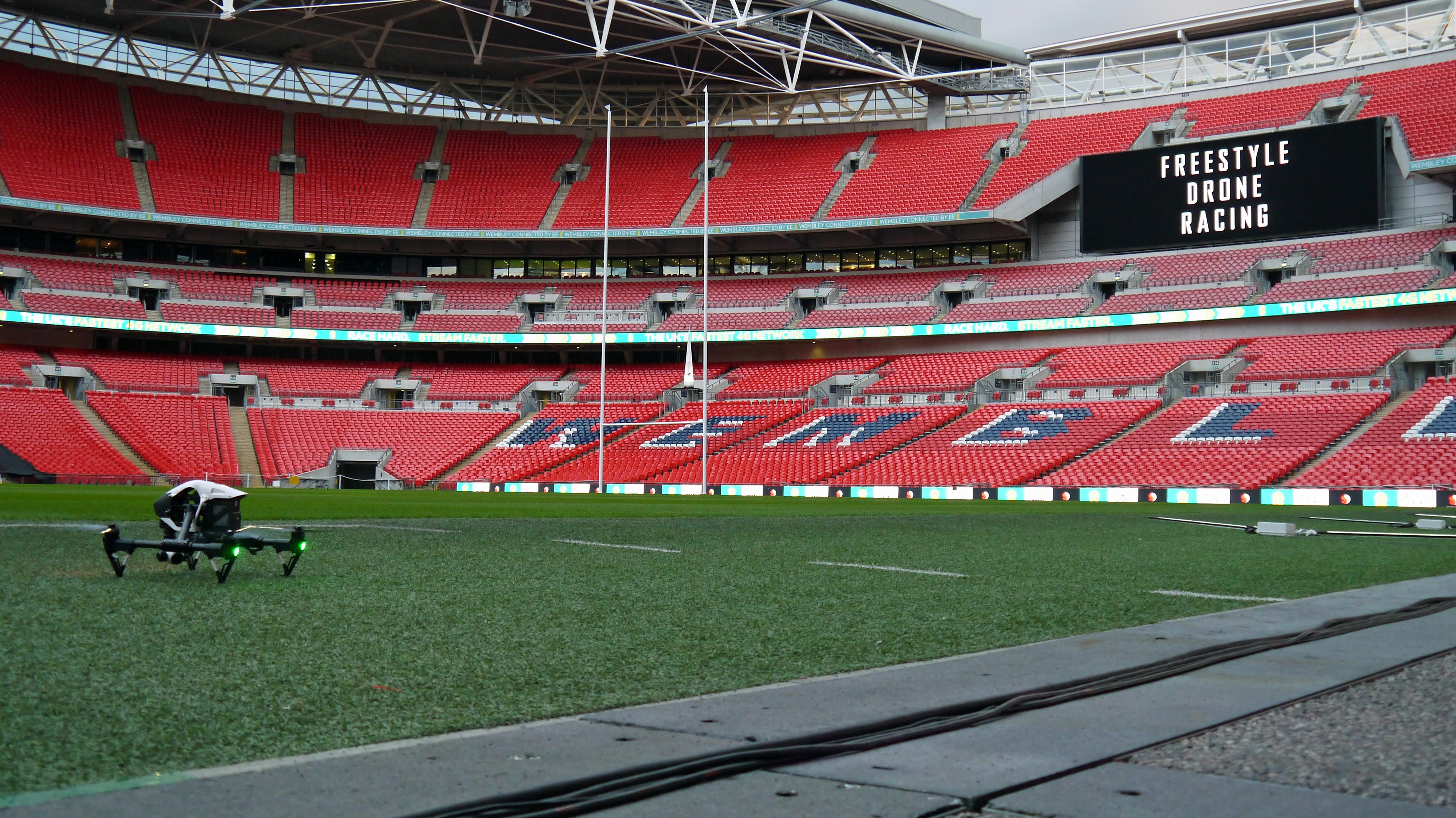
Luke Bannister is the current World Drone Prix champion. He's 16 years old.
Once you've gotten over young Luke's abundance of talent, and the $250,000 he netted as champion, let us tell your more about the world of drone racing.
This burgeoning sport, which has visited Dubai, LA, Miami and now the hallowed turf of London's iconic Wembley Stadium, doesn't just deal in big prize money - there's an awful lot of cool tech involved too.
Techradar grabbed an all-access pass to the FPV (First Person View) Freestyle Drone Race in London to see how a teenager could bag a quarter of a million by flying something that many consider a toy.
The drones
The core component of FPV Drone Racing, these quadcopters are capable of speeds of over 100mph and some surprisingly impressive handling - in the right hands.
As we were told during our briefing, putting a rookie at the controls of one of these would be like putting a learner driver in a F1 car. Unlike an F1 car though, these drones don't cost millions.
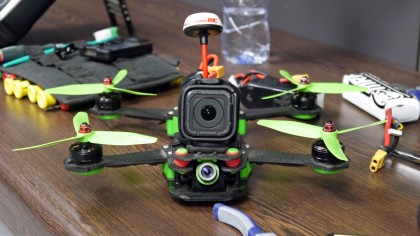
In fact, they're actually not that expensive at all. Speaking to professional drone pilot Danny Mijnders, aka Metal Danny, he explained the actual drones themselves only cost around £300 (around US$420, AU$550).
Get daily insight, inspiration and deals in your inbox
Sign up for breaking news, reviews, opinion, top tech deals, and more.
"If you're starting out, you'll probably need around £800 (around US$1,100, AU$1,400) for all the kit including an entry level racing drone, controller, repair kit, spare parts etc," he told us.
You can even pick up a racing drone off the shelf. It's a great way to get into the sport, but the professionals build theirs from parts and there's a surprising abundance of manufacturers for all the different components.
The technology
At the heart of the drones we saw zip around Wembley was Qualcomm's Snapdragon Flight chip, which squeezes a huge amount of tech onto a single board, allowing the drones to be smaller, lighter, safer, faster and fly for longer.
The chip is small enough to fit in your pocket and provides the brains for navigation, motors, imaging and connectivity.
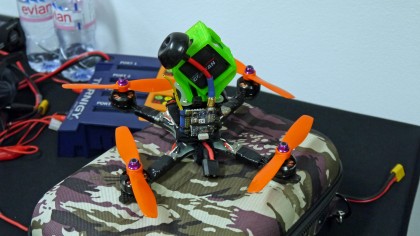
It's called First Person View Drone Racing for a reason, as the pilots don't just stand on the ground and watch their drone in the sky, but strap on a pair FPV goggles transporting them virtually to the cockpit of their drone.
We had a go at controlling a drone using the FPV goggles. Not a racing drone, mind; instead I was at the controls of a cheap toy drone which I attempted to land in a bin - and ultimately failed.
It's definitely not easy, and we've got a huge amount of respect for the pilots who somehow stay in ultimate control at speeds of over 100mph.
The fans
Each drone was equipped with EE's live streaming Action Cam, allowing fans to ride on board with the competitors.
We took a seat in the away dugout of Wembley Stadium, donned a pair goggles and skipped through the channels to select our competitor of choice.
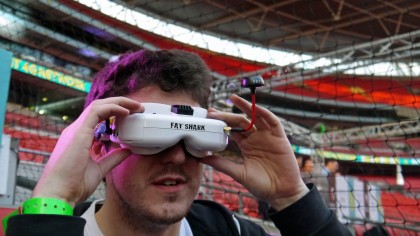
The start line was in the player's tunnel, and we watched as the flying machines zipped out through the double doors and into the vast expanse of the arena, gliding through gates, slaloming round large inflatable bollards and setting off possibly the loudest smoke cannon we've ever witnessed.
We could jump between drone cams mid race, and your world gets turned upside down when the drones hit the freestyle zone, where competitors must perform a trick before continuing with the lap.
And of course, there's always a 100mph collision, crash or showboat-gone-wrong to keep you entertained.
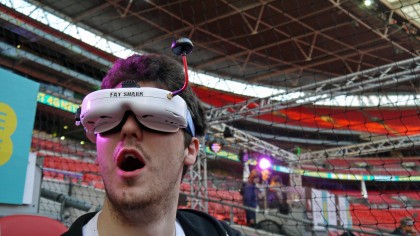
While the pilots enjoyed crystal clear footage, our goggles were lacking the same level of detail. The great thing about the live streaming technology is that you can also watch the action on a tablet or your mobile phone, with a stream quality much closer to that of the pilot's.
It also means you don't have to wear the fashionably questionable headset.
The pits
Wandering down the tunnel back into the bowels of Wembley we took a right, into the away dressing room, which was serving as a temporary pit stop for the drone racers.
Tools, drones, spare parts and battery charges littered the sides as pilots made final adjustments, and in some cases repairs, to their quadcopters.
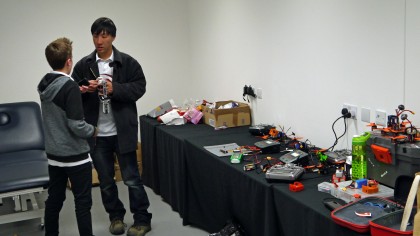
There is a surprising range of tuning that can be done, depending on the style of circuit. Ones with long straights and few corners call for larger propellers and higher speeds, while courses which are turn heavy require the drones to don smaller rotors for increased control and handling.
The future?
Attending the Freestyle Drone Racing event was certainly enjoyable, but there are questions over whether it can become a popular spectator sport.
The fast-paced nature and aerial dominance of the drones limits crowds. We were confined to heavily netted areas during races, which is sensible considering the speed the drones were going. They could inflict serious injuries if something went wrong.
That means you're not going to see a stadium such as Wembley filled to rafters as drones whizz overhead. There will need to be more separation, but with live streaming we could see fans stay on their sofas and enjoy the action from home.
It has all the right ingredients; high speeds, competitive races, and a certain element of danger and risk, and we can't wait to see where it goes from here.
Check out Parrot's new fixed-wing drone:

TechRadar's former Global Managing Editor, John has been a technology journalist for more than a decade, and over the years has built up a vast knowledge of the tech industry. He’s interviewed CEOs from some of the world’s biggest tech firms, visited their HQs, and appeared on live TV and radio, including Sky News, BBC News, BBC World News, Al Jazeera, LBC, and BBC Radio 4.